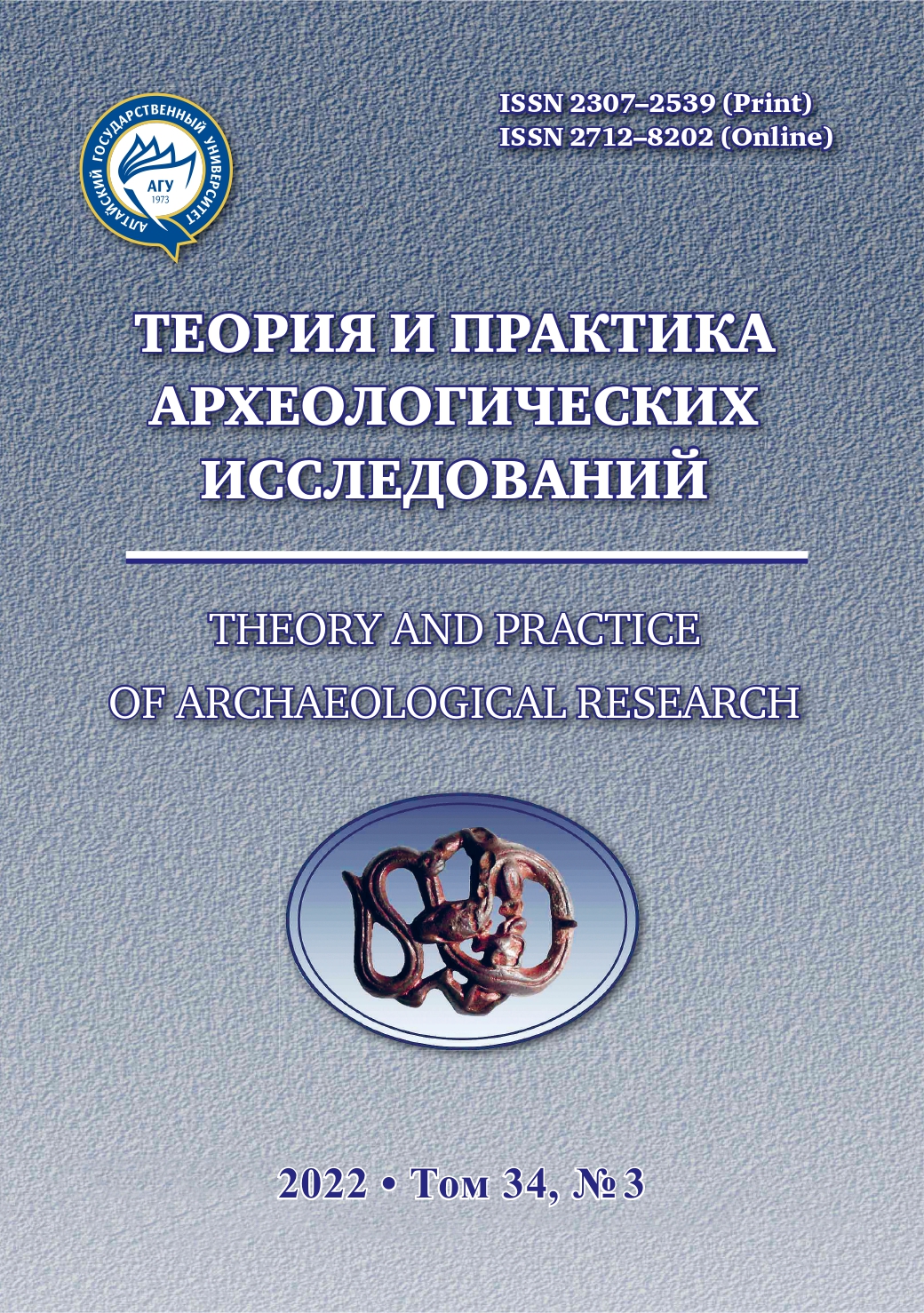TECHNOLOGICAL EXPLORATION AND RITUAL USE OF OBSIDIAN IN ANCIENT CULTURES OF THE PACIFIC
Abstract
The article examines a range of directions and current stage of obsidian studies within the Pacifi c basin such as (1) geochemistry, identifi cation of volcanic glass sources used in ancient cultures; (2) technology, obsidian exploration methods, their evolution, as well as experiments, and (3) cultural context, the use of obsidian in ritual practice, in the format of prestigious technologies, and in decorative art. While the geochemical studies have reached signifi cant progress within the Pacifi c basin two other directions obviously require further development. Experimental works, conducted in 2020–2021 in Primorye, allow making useful observations both about the peculiarities of the local raw material base and about the behavioral side of the knapping process (such as the process of teaching and learning of knappers’ competencies). In tu rn, the study of cultural meaning of obsidian includes not only the interpretation of the archaeological artifacts of high quality from the burials and caches (ritual, prestige, nonutilitarian), but also addressing to the ownership of the raw material sources, trade/ exchange mechanism, and the status of the highly - skillful knappers in ancient and traditional societies.
Downloads
Metrics
References
Bradley B., Stanford D. Th e North Atlantic Ice-Edge Corridor: A Possible Paleolithic Route to the New World. World Archaeology. 2004;36(4):459–478.
Ebert C. E., Dennison M., Hirth K. G., McClure S. B., Kennett D. J. Formative Period Obsidian Exchange along the Pacifi c Coast of Mesoamerica. Archaeometry. 2015;57:54–73. doi.org/10.1111/arcm.12095
Fladmark K. R. Glass and Ice. Th e Archaeology of Mt. Fdziza. Department of Archaeology, Simon Fraser University, Burnaby, B.C., 1985. Publication Nо.14. 217 p.
Freund K. P. An Assessment of the Current Applications and Future Directions of Obsidian Sourcing Studies in Archaeological Research. Archaeometry. 2013;55:779–793. doi.org/10.1111/j.1475-4754.2012.00708.x
Gillam J. C., Tabarev A. V. On the Path of Upper-Paleolithic Obsidians in the Russian Far East. Current Research in the Pleistocene. 2004;21(1):3–6.
Glascock M. D., Krypianko A. A., Kuzmin Y. V., Shackley S. M., Tabarev A. V. Geochemical Characterization of Obsidian Artifacts from Prehistoric Sites in the Russian Far East: Initial Study. In: Archaeology of the Northern Pacifi ca. Vladivostok : Dal’press, 1996. P. 406–410.
Gould R. A. Th e Indians of Northwest California. Masterkey. 1985;59(2–3):2–21.
Hayden B. Practical and Prestige Technologies: Th e Evolution of Material Systems. Journal of Archaeological Method and Th eory. 1998;5(1):1–55.
Heizer R. F., Treganza A. E. Mines and Quarries of the Indians in California. Quaternary Chapter of the State Mineralogist’s Report. 1944;XL:291–359.
Hodgson S. F. “Obsidian Spirits Just Speak Once” — California Indians in a Geothermal Land. Paper Presented at World Geothermal Congress. Antalya, Turkey, 24–29 April, 2005.
Hughes R. E., Bettinger R.L. Obsidian and Prehistoric Sociocultural Systems in California. Exploring the Limits: Frontiers and Boundaries in Prehistory. BAR International Series. 1984;223:153–172.
Kimura H. Obsidian Human Technology. In: Paleoecology of Pleistocene and Stone Age Cultures of Northern Asia and Adjacent Territories. Novosibirsk : Institute of Archaeology and Ethnography Press, 1998. P. 302–314.
Kornfeld M., Tabarev A. Th e French Connection? Or Is It? Current Research in the Pleistocene. 2009;26:90–92.
Kroeber A. L. Handbook of the Indians of California. Bureau of American Ethnology Bulletin. 1925;78:995 p.
Kuzmin Y. V. Geochronology and Paleoenvironment in Late Paleolithic and Neolithic of Temperate East Asia. Vladivostok : Pacifi c Institute of Geography, 2005. 282 p. (In Russian with English summary).
Kuzmin Y. V. Long-distance Obsidian Transport in Prehistoric Northeast Asia. Bulletin of the Indo-Pacifi c Prehistory Association. 2012;32:1–5.
Kuzmin Y. V., Glascock M. D., Sato H. Sources of Archaeological Obsidian on Sakhalin Island (Russian Far East). Journal of Archaeological Science. 2002;27(7):741–749.
Kuzmin Y. V ., Oppenheimer C., Renfrew C. Global perspectives on Obsidian Studies in Archaeology. Quaternary International. 2020;542:41–53. doi.org/10.1016/j.quaint.2020.02.036
Kuzmin Y. V., Glascock M. D., Vorobei I. E., Grebennikov A.V. Sourcing of Obsidian Artefacts from the Omolon River Basin and the Neighboring Region (north-eastern Siberia): Prehistoric Procurement from Kamchatkan and Chukotkan Sources. Archaeometry. 2021;63:1141–1156. doi.org/10 .1111/arcm.12675
Kuzmin Y. V., Tabarev A. V., Popov V. K., Glascock M. D., Shackley M. S. Geochemical Source Analysis of Archaeological Obsidian in Primorye (Russian Far East). Current Research in the Pleistocene. 1999;16:97–99.
LeBlanc R. Wedges, Pieces Equillees, Bipolar Cores, and Other Th ings: An ‘Alternative to Shott’s View of Bipolar Industries. North American Archaeologist. 1992;13:1–14.
Popov A. N., Tabarev A. V. Neolithic Cultures of the Russian Far East: Technological Evolution and Cultural Sequence. Turkish Academy of Sciences Journal of Archaeology. 2008;11:41–62.
Popov A. N., Tabarev A. V. Lords of the Shell Rings: Boisman Neolithic Culture, Russian Far East / Seigneurs des anneaux sur coquilles: la culture néolithique de Boismanskaya, Extrême-Orient russe. Séances de la Société préhistorique française. 2016;6:393–408.
Popov A. N., Tabarev A. V. Th e Preagricultural Human Occupation of Primorye (Russian Far East). In: Handbook of East and Southeast Asian Archaeology. New York : Springer, 2017. P. 379–396. doi.org/10.1007/978-1-4939-6521-2_24
Popov A. N., Tabarev A. V., Mikishin Y. A. Neolithization and Ancient Landscapes in the Southern Primorye, Russian Far East. Journal of World Prehistory. 2014;27(3):247–261. doi.org/10.1007/s10963-014-9073-1
Powers S. Tribes of California. Contribution of North American Ethnology. 1877;3:645.
Rust H. N. Th e Obsidian Blades of California. American Anthropologist. 1905;7:688–689.
Shackley M. S., Glascock M. D., Kuzmin Y. V., Tabarev A. V. Geochemical Characterization of Archaeological Obsidian from the Russian Far East: A Pilot Study. Paper Presented at International Symposium on Archaeometry. University of Illinois of Urbana. Champaign, Urbana, 1996.
Shott M. On Bipolar Reduction and Splintered Pieces. North American Archaeologist. 1999;20(3):217–238.
Tabarev A. V. On the Dark Side of the Neolitisation: Evidences of Violence in the Neolithic Burials at Boisman-2 Site, Russian Far East. In: Neolithization and Modernization: Landscape History on East Asian Inland Seas. Kyoto : Nakanishi printing Co Ltd, 2009. P. 131–138.
Tabarev A. V. Blades and Microblades, Percussion and Pressure: Towards the Evolution of Lithic Technologies of the Stone Age Period, Russian Far East. In: Th e Emergence of Pressure Blade Making: From Origin to Modern Experimentation. New York : Springer, 2012. P. 329–346. doi.org/10.1007/978-1-4614-2003-3_13
Tabarev A. V. Th e Later Prehistory of the Russian Far East. In: Th e Cambridge World Prehistory. V. 2. East Asia and the Americas. New York : Cambridge University Press, 2014. P. 852–869. doi:10.1017/CHO9781139017831.058
Tabarev A. V., Ivanova D. A., Kanomata Y. Knap and Keep: Late Paleolithic-Neolithic Caches, Far East. Documenta Praehistorica. 2021;48:2–11. doi.org/10.4312/DP.48.7
Theory and Practice of Archaeological Research is a golden publisher, as we allow self-archiving, but most importantly we are fully transparent about your rights.
Authors may present and discuss their findings ahead of publication: at biological or scientific conferences, on preprint servers, in public databases, and in blogs, wikis, tweets, and other informal communication channels.
Theory and Practice of Archaeological Research allows authors to deposit manuscripts (currently under review or those for intended submission to ABS) in non-commercial, pre-print servers such as ArXiv.
Authors who publish with this journal agree to the following terms:
- Authors retain copyright and grant the journal right of first publication with the work simultaneously licensed under a Creative Commons Attribution License (CC BY 4.0) that allows others to share the work with an acknowledgement of the work's authorship and initial publication in this journal.
- Authors are able to enter into separate, additional contractual arrangements for the non-exclusive distribution of the journal's published version of the work (e.g., post it to an institutional repository or publish it in a book), with an acknowledgement of its initial publication in this journal.
- Authors are permitted and encouraged to post their work online (e.g., in institutional repositories or on their website) prior to and during the submission process, as it can lead to productive exchanges, as well as earlier and greater citation of published work (See The Effect of Open Access).








2.jpg)




